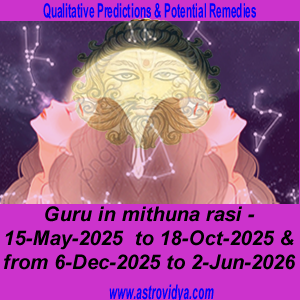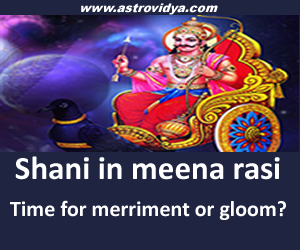

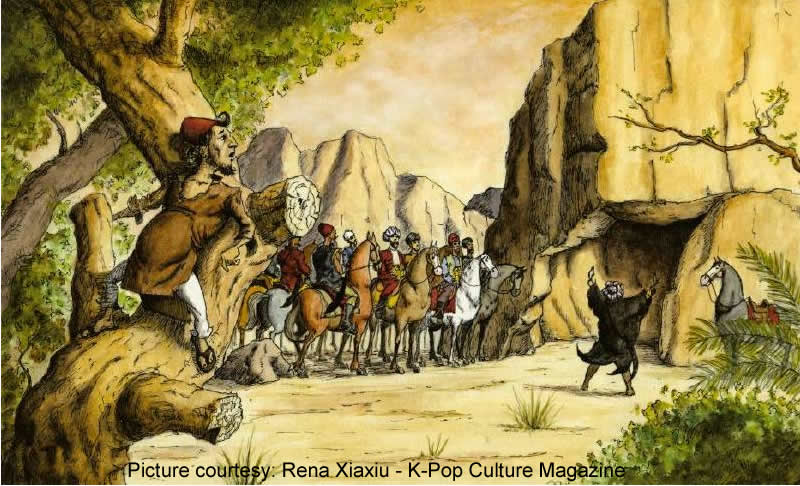
Open Sesame
Write-ups at a glance
Write-ups at a glance
Search by Google:



Disclaimer: All material on the site, www.astrovidya.com are for entertainment purposes only and no guarantee is implied as to the accuracy of contents or advertisements contained in or linked to this website. The contents are based on ancient cannons of astrology and should not be interpreted as legal, financial, political, religious, ethical, medical, psychological, psychiatric or any other specialist advice. The user is wholly responsible for his choices, decisions, judgments and risks. In no event shall the site be liable for any direct, indirect, incidental, punitive or consequential damages of any kind whatsoever with respect to its service, materials and products. By using the services you confirm that you are over 18 and that you understand and agree with these terms of Disclaimer. If you disagree with any part of these terms and conditions, please egress the website.
Lord Ganesha - the Elephant-God on a mouse - is worshipped before the commencement of any function. He is the Lord of success and destroyer of all. He is also worshipped as the god of education, knowledge and wisdom. Sri Shankara Bhagawadpada advocates worship of Ganesha in Panchayanatana pooja. In the Ganapathyatharva Upanishad, Ganesha is praised as the Supreme Self. The legends that are connected with Lord Ganesha are available in the Ganesha Khanda of the Brahma Vivartha Purana. Ganesh Chaturthi is celebrated as the birthday of Lord Ganesha on the fourth day (Chaturthi) of the bright fortnight of Bhadrapada. Ganesh puja is performed in all temples. Hindus worship the idols of Lord Ganesha, made especially for the occasion two or three months prior to the festival. Gulur, near Tumkur in Karnataka houses a beautiful Ganesha idol. No other state can surpass Maharastra in decorations and processions. Cultural programs in Tamil Nadu are very great. On the day of the head of the household invokes the Lord with a specific mantra, after regular mantras used in any worship. Shodashopachara pooja follows this.
Ganesha is worshipped with varieties of grass particularly twenty-one durva grass shoots and various flowers. Sweets made up of rice called Modakas are offered to Lord Ganesha. In some of the temples, Ganesha Homa is also conducted. In Ganesha worship whole neighborhood is involved. They donate the funds, gather at the place where the community Ganesha is placed and organize cultures events in the evenings. Next ten days, Ganesha is worshipped in this fashion. On the eleventh day, the image is taken in a procession and immersed in water. This event called Visarjan (Nimajjan), symbolizes His journey towards his Kailash Mountain taking away with Him all the misfortunes of the devotees. Amid the shouting "Ganapathi Bappa Morya, Purchya Varshi Laukariya" immersion takes place. Lord Ganesha’s worship was prevailing earlier in Karnataka and in the times of Vijayanagar kings, a saint named Morya Goswami brought it to Maharasta. Hence in Maharastra, Ganesha is known as Bappa moraya (father of Morya). During independence movement Lokamanya Tilk utilized Ganesha Chaturthi as a means of unity. Ganesha Chaturthi is celebrated by one and all across all cults, communities, sects, and castes under the Hindu fold. One should not look at the Moon on the day of Ganesha Chaturthi. Once Moon made fun of Lord Ganesha and suffered the consequences. The real meaning is that one should not associate himself with the people who do not relay on the God or religion.
Ganesha is worshipped with varieties of grass particularly twenty-one durva grass shoots and various flowers. Sweets made up of rice called Modakas are offered to Lord Ganesha. In some of the temples, Ganesha Homa is also conducted. In Ganesha worship whole neighborhood is involved. They donate the funds, gather at the place where the community Ganesha is placed and organize cultures events in the evenings. Next ten days, Ganesha is worshipped in this fashion. On the eleventh day, the image is taken in a procession and immersed in water. This event called Visarjan (Nimajjan), symbolizes His journey towards his Kailash Mountain taking away with Him all the misfortunes of the devotees. Amid the shouting "Ganapathi Bappa Morya, Purchya Varshi Laukariya" immersion takes place. Lord Ganesha’s worship was prevailing earlier in Karnataka and in the times of Vijayanagar kings, a saint named Morya Goswami brought it to Maharasta. Hence in Maharastra, Ganesha is known as Bappa moraya (father of Morya). During independence movement Lokamanya Tilk utilized Ganesha Chaturthi as a means of unity. Ganesha Chaturthi is celebrated by one and all across all cults, communities, sects, and castes under the Hindu fold. One should not look at the Moon on the day of Ganesha Chaturthi. Once Moon made fun of Lord Ganesha and suffered the consequences. The real meaning is that one should not associate himself with the people who do not relay on the God or religion.
GANESH CHATURTHI

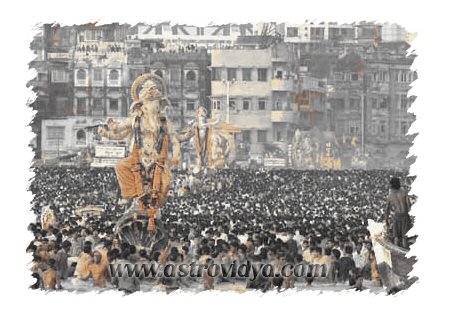
In ancient India trade by sea routes had flourished well. The word 'navy' is the derivative of Sanskrit word, 'Nouka'. In medieval period Cholas, Yadavas and Pandya kings expanded their kingdoms beyond present day India and conducted trade with Srilanka and many countries in Far East. The concept of Ganesh pooja spread far and wide. Jains (Swetambars) and Buddhists also worship Ganesh. Ganesh Chaturthi is observed in India, East and Far East. On Ganesha Chaturthi, idols of the Ganesh in various forms and shapes are installed. Ganesha is offered 21 modakas (a delicacy prepared from rice, wheat and jiggery). The number 21 has a special significance - it represents five organs of perception, five of action, five pranas (airs), five elements and mind. That means all the body, mind and resources are dedicated to the Lord. Ganesh is worshipped with durva grass which has sharp edges. It is deemed fit for the offering as it is not touched by other animals. The pooja and cultural programmes in community halls are continued for nearly ten days. The idol is taken in a grand procession and immersed in a water body. Police in the entire country would be in jitters; hoax bomb calls and at times real bombs keep them engaged. The communal tensions run high.
they identify as Iyengers, Aiyers, Smartas and the list goes on! Hindu brothers of lower casts are not treated with respect by upper strata, yet another man is given special status as if he is the direct descendant of Queen Victoria! Divided we fell and we enjoy falling further more.Ganeshji is worshipped before start of any function or any pooja. On Ganesh chaturthi day, he is specially worshipped. That is why we find two Ganesh worships on that day - one the regular pooja as done before any other pooja and a special pooja for Ganesh. Ganesh prevails in many forms and on Ganesh Chaturthi the Bestowing Ganesh, Varasiddi Vinayaka is worshipped. Ganesh is invoked with the mantra: गणानां त्वा गणपतिं हवामहे कविं कवीनामुपमश्रवस्तमम्। ज्येष्ठराजं ब्रह्मणां ब्रह्मणस्पत आ नः शृण्वन्नूतिभिः सीद सादनम्॥
Many wars are fought in the name of religion. One should be religious and not fanatics. People make fun of their Gods many times a year, they call a fat man-Ganesh, they tease the other as Hanuman, meaning a monkey! Yet, with great faith they worship their Gods! One can not expect such liberalized views from all. Hindus let all the people set up their shops on his land, permitted them to conduct trade, sanctioned lands for their places of worship and due to their in fighting, let others invade the country and rule for a longer periods. Even today, a Hindu does not say he is a Hindu, he says he is a Brahmin or a Vaishya and likewise. Brahmins do not say they are Brahmins;
"O God! O Ganapati! Among us, your subjects, You are our master. Hail to you. Among those who are wise, You are the wisest. Among superiors, You are the highest lord. Among the glorious, You are the most glorious. Among the souls, You are the Supreme Soul. With this prayer, Lord, we are asking You to bless us with your presence in our midst to give us Your protection". [Rigveda:Mandala2; Sukta23; Mantra1]. This mantra is in praise of God Brihaspati (Brahma) and is scripted by sage Grutsamada. The words 'ganapati' 'ganesh' are rarely used in Rigveda. Another mantra is found in Mandala 10.
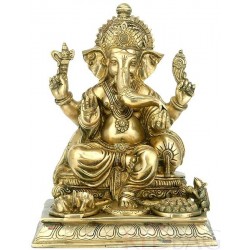
निषु सीद गणपते गणेषु त्वामाहुर्विप्रतमं कवीनाम्।न ऋते त्वत्क्रियते किं चनारे महमर्कं मघवन् चित्रमर्च॥ "Lord of the hosts, amid our bands be seated: they call thee greatest Sage among the sages. Nothing is done, even far away, without thee: great, wondrous, Maghavan, is the hymn I sing thee". [Rigveda:Mandala10; Sukta112; Mantra 9] Brahmanaspati (Brihaspati, Brahma, creator), Indra (the king of Gods), Maghavan (adjective, meaning the Great One), Agni (one of the five elements) and Rudra (who regulates the time scale) are called Ganapati. Gana means subjects and Pati, the master. In Rigvedic times no such God equivalent to present day Ganesh was being worshipped. Harappans used to call the village head as Ganapathi. Present day worship of Ganesh is fusion of Dravidian and Aryan cultures. Both these cultures mixed freely and another culture representing the cream of both was formed. Sayanacharya formulated the methods of worship. There were many people who worshiped Durga, Vishnu, Surya, Navagrahas and Ganapathi. The upasakas of Ganapathi were called Gaanapatya. Sri Shankara Bhagawadpada brought them together by advocating Panchayatana Pooja (Pooja for all these five Gods). My friend asks me," Brother, how can you regard strange animals such as elephant headed man or a monkey as your Gods?". Did God appear to Moses as a laser beam, scrolling on the rocks? Is God a laser Gun? God appeared to Moses on Horeb as 'no figure of any kind' (Deuteronomy 4 verses 15-19). How does the film director show this on the silver screen? So, in the movie Ten Commandments, God is symbolised by a beam of light.
My Brother usually thinks that God is formless and believes that He is rightfully depicted as a beautiful sunrise. But God appeared to Ezekiel "..........upon the throne, a form in human likeness" (Ezekiel 1 verses 26-28). How do we describe a grand phenomenon known as God, without symbols and words? Obviously, we require some hair, a tooth, a hand or a blood stained cloth to represent God. Popular belief is that 'my God is God and yours is dog'. [With due apologies to my third daughter Ruby, who is from Canine world]. May the blessings of Sri Ganesha be with you all! May He remove all the obstacles that stand in your progress!
My Brother usually thinks that God is formless and believes that He is rightfully depicted as a beautiful sunrise. But God appeared to Ezekiel "..........upon the throne, a form in human likeness" (Ezekiel 1 verses 26-28). How do we describe a grand phenomenon known as God, without symbols and words? Obviously, we require some hair, a tooth, a hand or a blood stained cloth to represent God. Popular belief is that 'my God is God and yours is dog'. [With due apologies to my third daughter Ruby, who is from Canine world]. May the blessings of Sri Ganesha be with you all! May He remove all the obstacles that stand in your progress!



